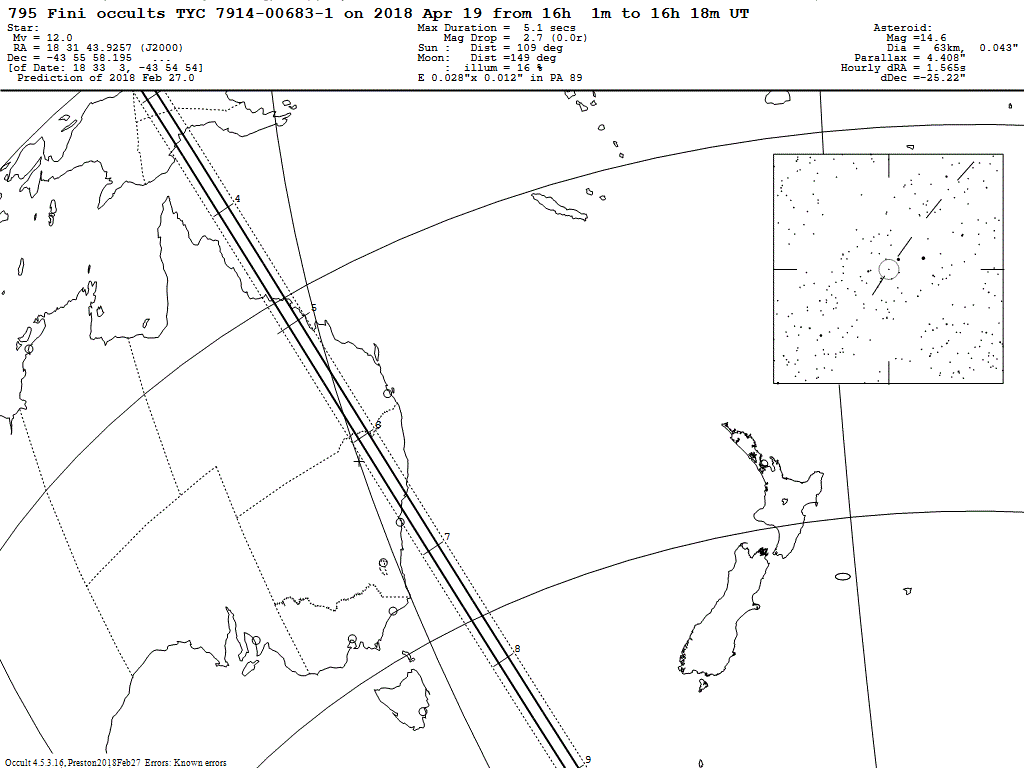Updated: 2018 Feb 27, 18:55 UT
Event Rank : 72
(The event Rank is a measure of the likelihood of observing an event, and is equal to the probability of at least one successful observation by a team of two observers spaced 1/8 path width just inside opposite sides of the predicted path. An event rank of 100 indicates that the prediction is expected to be very accurate).
THE UPDATED PATH
Note: The duration given in the line below is the interval during which the occultation shadow sweeps across the Earth - please see the minute markers on the map to determine the approximate time for your location.

On 2018 Apr 19 UT, the 63 km diameter asteroid (795) Fini will occult a 12.0 mag star in the constellation Corona Australis for observers along a path across eastern Queensland and north-eastern New South Wales, passing near Proserpine, Tamworth and Newcastle.
In the case of an occultation, the combined light of the asteroid and the star will drop by 2.71 mag to 14.57 mag (the magnitude of the asteroid) for at most 5.1 seconds.
This update is based on UNSO/Flagstaff astrometry for the asteroid kindly provided by Hugh Harris, astrometry for the asteroid kindly provided by Bill Owen, astrometry for the asteroid kindly provided by the IAU Minor Planet Center.
Additional details of this and other events are available at Steve Preston's website at http://www.asteroidoccultation.com/
EVENT DETAILS SUMMARY :Important Note regarding Accuracy:
The uncertainty interval in path widths given above (and shown as a 1-sigma uncertainty ellipse on the plot) refers to RMS deviation and is applied as a +/- range. In other words, a path uncertainty of 1.0 path widths means that the actual center of the asteroid's shadow path should fall within plus or minus 1 path width of the plotted path center. However path errors larger than 1 sigma have been observed so observers should be alert for primary occultations within plus or minus 3 sigma of the updated path.
Further, almost all asteroidal satellites discovered so far have been found within 10 diameters of the asteroid (since this distance is deep enough within the gravitational well to be stable over long timescales). Therefore, if monitoring for secondary events, observing out to about 10 path-widths either side of the predicted track remains worthwhile.
We therefore recommend that you monitor for events if your observing location is up to +/- 10 path-widths from the predicted track. If not monitoring for occultations by secondary bodies you should observe from locations within 3 sigma of the nominal path.
In terms of time, the predictions are now usually accurate to about +/- 0.3 minute so you should be most attentive during the predicted minute of the event. However if intending to catch a potential satellite occultation you should start observing at least 10 times the predicted central duration before the predicted closest approach time for your location, and continue for a similar period afterwards.
Occultation of TYC 7914-00683-1 by 795 Fini on 2018 Apr 19
Centre Star Star Sun Path Limit1 Path Limit2 Error Limit1 Error Limit2 Alt
E. Longitude Latitude U.T. Alt Az Alt Crn
o ' " o ' " h m s o o o o ' " o ' " o ' " o ' " o ' " o ' " o ' " o ' "
Longitude Latitude Longitude Latitude Longitude Latitude Longitude Latitude
147 21 58 -17 37 4 16 4 30 46 136 -62 147 41 55 -17 36 21 147 1 57 -17 37 41 148 7 46 -17 35 16 146 35 46 -17 38 19 0.40
149 44 46 -25 16 53 16 5 30 53 131 -57 150 5 18 -25 15 27 149 24 10 -25 18 12 150 31 57 -25 13 27 148 57 12 -25 19 47 0.41
151 45 44 -32 23 8 16 6 30 59 123 -53 152 7 24 -32 21 11 151 23 59 -32 25 0 152 35 31 -32 18 30 150 55 33 -32 27 17 0.41
Uncertainty in time = +/- 3 secs
Prediction of 2018 Feb 27.0
Use these links for further information:
[Planetary Occultations]
[Using the Predictions]
[Observing Details]
[Timing Details]
[Reporting Details]
[Report Form]
[Asteroid Occultation Results]
[Top of Page][Return to Home Page]